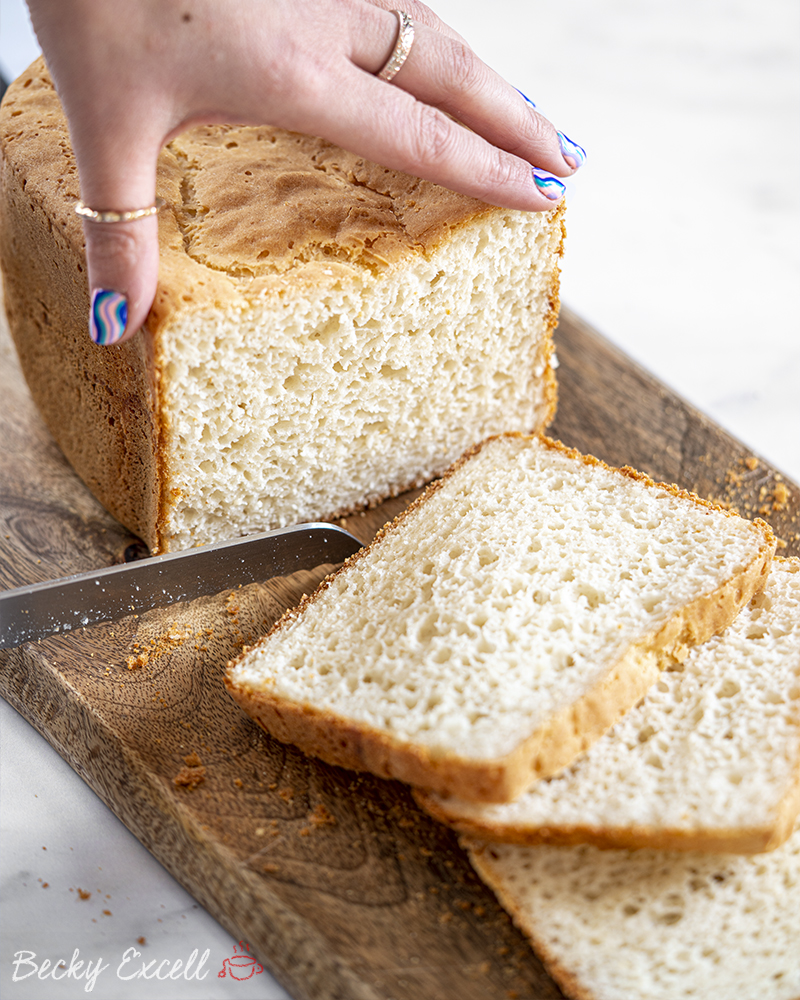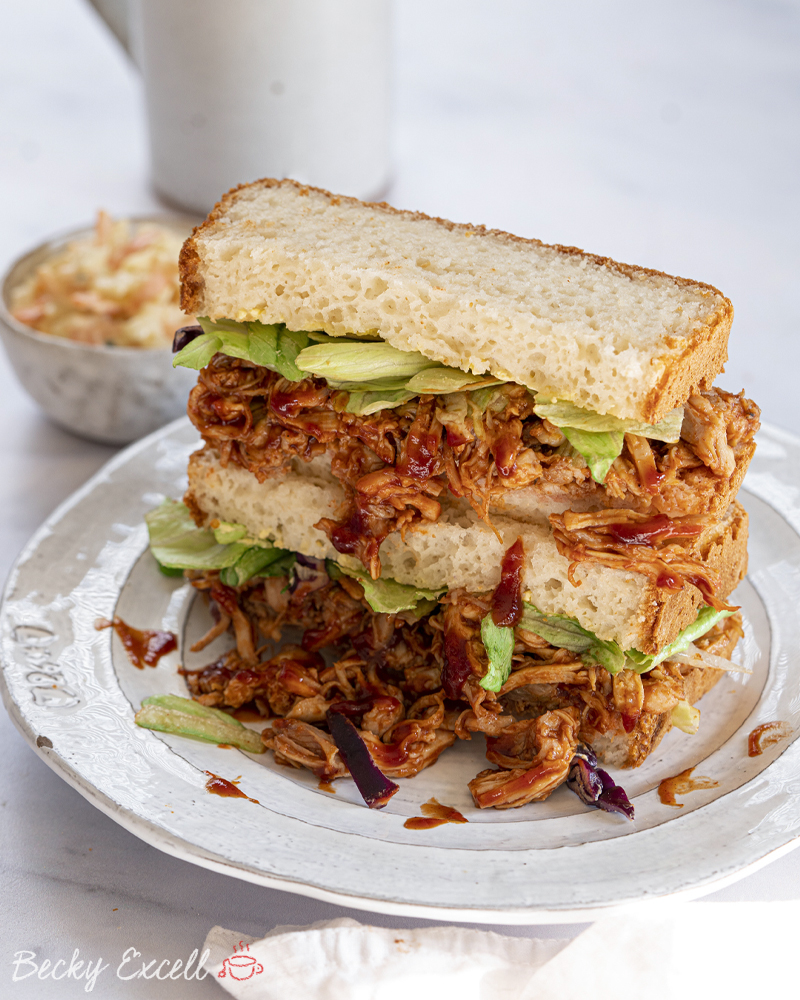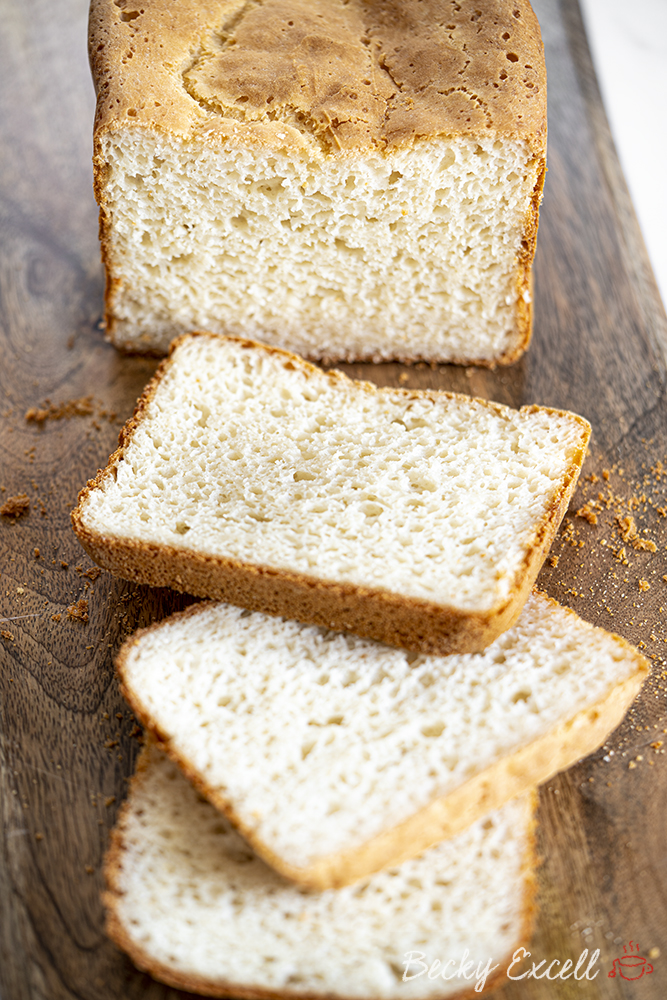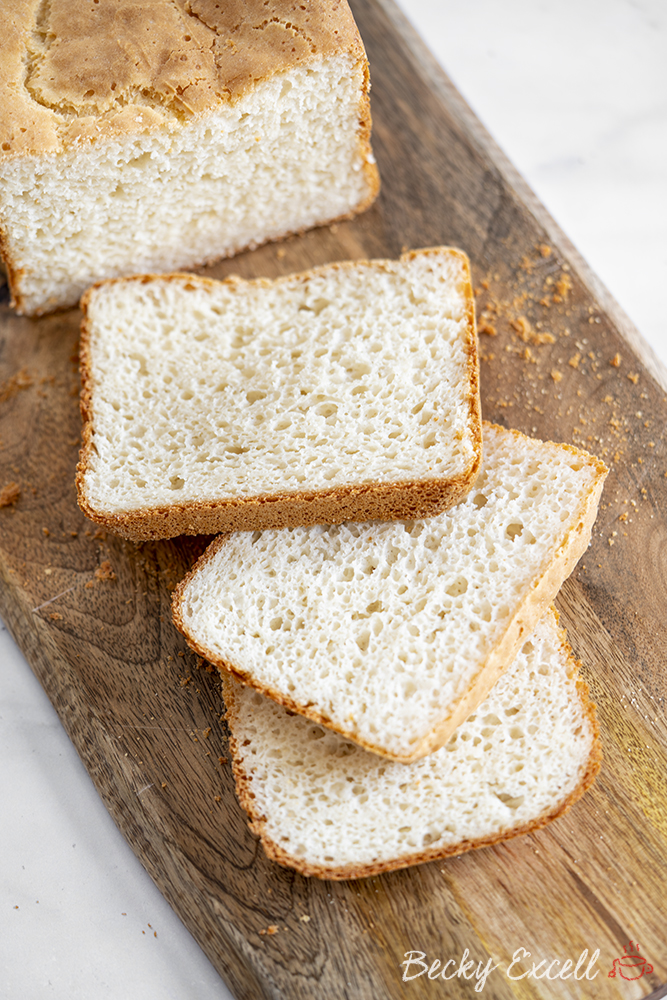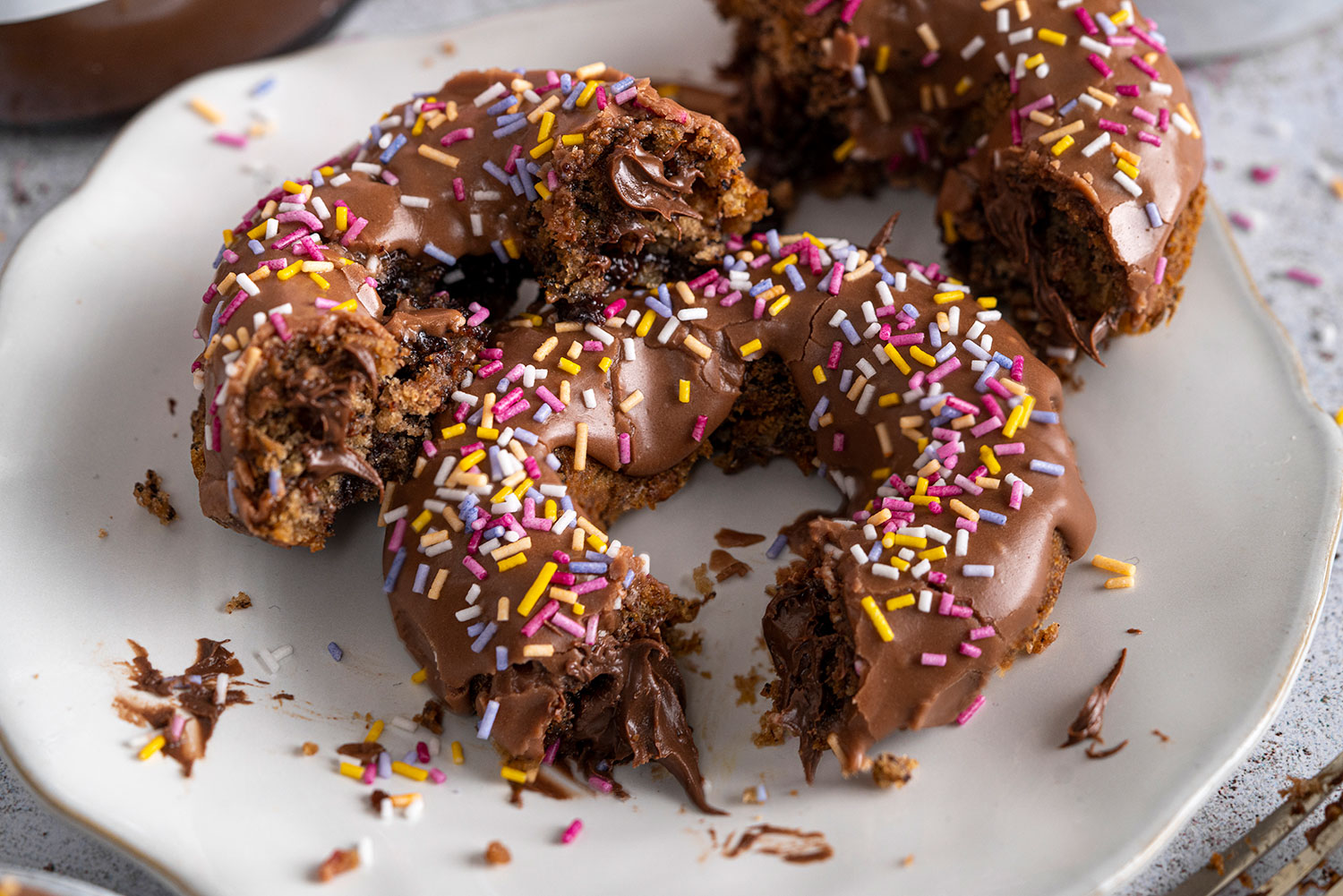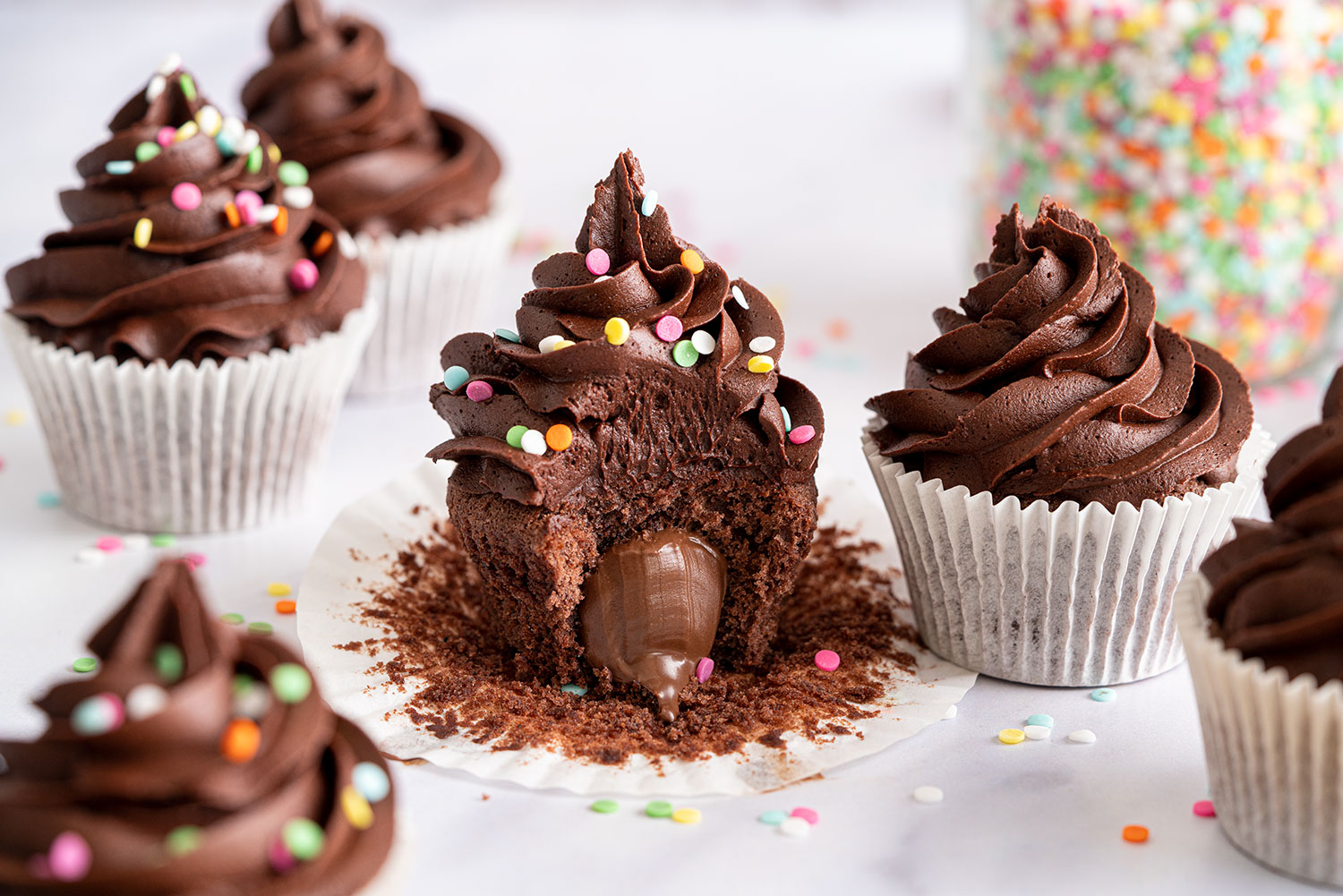Gluten-free white breadmaker loaf recipe – it’s finally here! This fresh loaf can easily be made using ingredients you can easily source in supermarkets and is so easy to make. It’s Coeliac-friendly and wheat-free too, of course!
Gluten-free white breadmaker loaf recipe – a super easy recipe that produces wonder fresh gluten-free bread with minimal effort. That’s what a breadmaker is for right?
I should probably start by saying that I’ve worked with Panasonic breadmakers in a paid capacity for years. But this is not a sponsored post, nor am I here to flog you a breadmaker – I just have to get that part said first!
I mention this especially as I’ll be highlighting which breadmaker I used to make this recipe (see the FAQ section for that). Other breadmakers are available, of course ?
But it’s especially important to mention as, if you want to get the exact same result as you see here, using the exact breadmaker is an easy way to do so.
Of course, I haven’t tested this in any breadmakers other than my own so please let me know your make and model and how it turned out. It will be very helpful for others who may have the same machine as you!
Why make my gluten-free white breadmaker loaf recipe?
- Fresh gluten-free bread is very hard to come by, as I’m sure you know. But with a breadmaker, it can be yours with very, very minimal effort.
- Can I add the smell of fresh bread filling your house? It’s not something a gluten-free person gets to experience very often, if at all!
- It tastes LIKE BREAD. I think that’s the best compliment I can give it! Of course, for a non-breadmaker recipe with a little extra ‘muggle-like’ quality, see the crusty white recipe in my first book.
- A gluten-free breadmaker is a fantastic investment… as long as you get good use out of it! So feel confident that you’ve already got one foolproof recipe ready to try.
- This recipe uses very simple ingredients, all of which you can find in supermarkets. No psyllium husk powder required!
So what does my gluten-free white breadmaker loaf taste like?
As I said… like bread! It has a lovely crusty finish which is often impossible to find in gluten-free bread. It’s miraculously flexible, not heavy or dense and has a lovely light crumb.
In terms of actual taste, as gluten-free bread flour is neutral-flavoured, there’s no strange aftertaste like some specific gluten-free flours can provide. It just tastes like a wonderful white loaf!
All in all, it’s perfect for sandwiches, toast with a bit of butter (especially in thick, chunky slices) and whatever else your heart desires.
Here’s everything you’ll need for this recipe, keep scrolling until you see the recipe card for the measurements and method…
Gluten-free white breadmaker loaf recipe: What you’ll need…
- Milk – Liquid in gluten-free bread is super important and ensuring some of it is milk is equally as integral. Milk contains protein which adds structure and also, it ensures you get a lovely colour to your bread.
- Water – A mix of water and milk stops the bread from getting too brown. I simply warm my milk/water mix in the microwave until warm to the touch – not boiling hot!
- Vegetable Oil – Believe it or not, oil is also integral in gluten-free bread so please don’t leave this out!
- Large Eggs – You might not expect to see eggs in bread, but believe it or not, they’re vital in fresh gluten-free bread. They add leavening and structure which is exactly what we need.
- Cider Vinegar – This softens the bread and the acidity reacts with the milk. And no – it doesn’t make your bread taste like vinegar whatsoever.
- Caster Sugar – A little sugar goes a long way and of course, helps to achieve the perfect finish on the crusty exterior.
- Gluten-free white bread flour (I use Doves Farm’s FREEE flour) – I chose this mix because it’s a lighter blend, but you’re welcome to try gluten-free plain flour too.
- Salt – White bread is completely neutral-flavoured, so a little salt is always welcome.
- Xanthan gum – Ah, that magic powder that makes gluten-free baking work! I haven’t tested this without it, so please include it if you can. You can find it down the free from aisle in supermarkets.
- Easy-bake yeast – First of all, ensure it’s gluten-free AND in date! Expired yeast doesn’t work as well, if at all. Also note that this is different to dried active yeast and swapping them won’t work AT ALL.
So I thought I’d kick things off with a little frequently asked questions section – if you just want the recipe, then keep scrolling.
But I’ve thrown in some tips here that will be really helpful if this is your first time making this, or you want to adapt it. So here they are!
Gluten-free white breadmaker loaf recipe: Frequently Asked Questions
Is this recipe gluten-free?
It is gluten-free, though nobody would know just by tasting it – trust me!
Bear in mind that minimising cross-contamination is hugely important if you’re Coeliac or making this for someone who is. Here’s some tips from Coeliac UK on minimising the risk of cross contamination.
Also, make sure that all ingredients used don’t have any gluten-containing ingredients. Then make that that they also don’t have a ‘may contain’ warning for gluten, wheat, rye, barley, oats (which aren’t gf), spelt and khorasan wheat (aka Kamut).
Here’s some more info from Coeliac UK on identifying safe gluten-free products.
Can I make your gluten-free white breadmaker loaf recipe dairy free?
Yup, just use dairy-free milk!
Can I make your gluten-free white breadmaker loaf recipe vegan?
I haven’t tested this using egg replacers for the eggs, but you’re welcome to give it a go. I’d probably go for 6 tbsp of aquafaba (prewhisked until frothy) if I gave it a go.
Please let me know in the comments if you test aquafaba in place of the eggs before I do! Of course, use dairy-free milk too.
Is your gluten-free white breadmaker loaf recipe low FODMAP?
If you use lactose-free milk, then yes!
What breadmaker do you use to make your gluten-free white breadmaker loaf?
As I said earlier, I’ve worked with Panasonic to promote their breadmakers for years, but this is not a sponsored post.
However, that does mean that of course, I use a Panasonic breadmaker! More specifically, the Panasonic 2540 breadmaker & also the Panasonic 2530 breadmaker.
Before they kindly gifted me with the fancier, newer model (only a couple of months ago), I used the Panasonic 2522 breadmaker.
I can vouch for both being perfect for this recipe because I’ve tested in both – plus, they both have a gluten-free setting, which I use for this recipe.
Will this work in any breadmaker?
The correct (unhelpful) answer is that I have no idea! I’ve only ever owned and used the two breadmakers listed above so I can only speak for those.
The fact that they both have a gluten-free bread setting also means I can’t really speak for the outcome of this recipe in machines that don’t have such a setting.
I’m told by you lovely, helpful people that most breadmakers have a ‘rapid’ setting, which might work well instead, but again, I can’t make any promises.
If you guys could let me know your make and model, as well as which settings you used below in the comments, that would be infinitely helpful to myself and others. As long as it turned out well of course ?
Can I make your gluten-free white breadmaker loaf recipe without a breadmaker?
You can try, but I cannot then advise you on timings whatsoever, unfortunately. I just whack on the gluten-free setting and hit start! I have no idea how long it mixes for or proves for as it does both in one straight session.
In the same way, I also couldn’t advise you on baking timings because the size of the breadmaker tin is very different to a regular tin. Also, breadmakers don’t have a clear timer, so I can’t easily say when it starts baking and how long for.
So the answer is: you can try, but you’d need be somewhat experienced to know how long to mix for (until combined, smooth and consistent), when the dough is sufficiently proved and when the bread is done baking in the oven. Sounds like a bit of an experiment to me!
The best idea if you want to make non-breadmaker bread is to just use the crusty white loaf in my first book.
My breadmaker doesn’t have a yeast dispenser, what do I do instead?
Simply add the yeast with the rest of your dry ingredients. A yeast dispenser adds the yeast automatically at just the right moment, ensuring it gets fully mixed in, but it’s not mandatory.
Can I use other types of vinegar?
Yes, as long as they’re gluten-free!
My breadmaker doesn’t have a gluten-free function, what do I do?
As I said above, most breadmakers have a ‘rapid’ setting, which might work well instead, but again, I can’t make any promises as to how it’ll turn out. Mainly because I’ve never used any machine other than my own!
Different settings can have vastly different timings for mixing, proving and baking, so you’ll have to give it a try and see what works best for you.
Where do I find easy-bake yeast? Can I use dried active instead?
You can find easy-bake yeast down the ‘muggle’ baking aisle. Please ensure it’s gluten-free! Here’s the one I use.
Easy-bake yeast is perfect for breadmakers as it doesn’t need to be activated (mixed in with warm water and sugar for 10 minutes until frothy) before using.
Dried active yeast will NOT work unless activated first, which isn’t ideal for breadmakers. So no, definitely don’t use dried active for this recipe.
I’ve cut my loaf and it’s sticky inside, what did I do wrong?
You must always wait for your bread to fully cool before slicing, otherwise it will be sticky – it’s not done yet!
The bread isn’t done until it’s fully cooled, so please exercise some patience (I know it’s hard when it smells and looks so good) before slicing.
Can I use gluten-free plain flour instead of gluten-free white bread flour?
I’d say you’d be fine to do so, but of course, I cannot speak for the results.
Gluten-free plain flour is a little ‘heavier’ than gluten-free bread flour, so there might be a little difference, but I’d imagine it’d still turn out just fine.
Can I make this recipe using other gluten free flours like buckwheat flour or coconut flour?
There’s a big difference between ‘gluten free plain/self-raising flour’ and a *singular* type gluten free flour.
When I say ‘gluten free plain or self-raising flour’ in a recipe, I mean a BLEND of gluten free flours, not just one, singular flour. I buy mine down the free from aisle of my local supermarket.
Definitely go for a gluten free flour blend.
Do I need weighing scales to make your gluten-free white breadmaker loaf?
In short… yes, yes and yes! And I wouldn’t advise attempting any my recipes without them.
A lot of work went into fine tuning ratios and quantities and for me, baking is all about consistency and precision. I want you to make this recipe and for it to turn out EXACTLY like mine did.
I’d recommending using digital cooking scales like these so you know you’re getting an accurate measurement and replicating my recipe as accurately as poss.
How long can I keep my gluten-free white breadmaker loaf for?
I’ve kept it for about 3-4 days in an air-tight container (once cooled) with no problems. Of course, you can also slice and freeze it, then pop the slices in the toaster straight from the freezer.
Gluten-free white breadmaker loaf recipe: Method
Oh and here’s a printable version of my gluten-free white breadmaker loaf recipe. Please remember to give it 5 stars if you tried it and enjoyed it as it helps people know it’s worth trying too! ⭐️
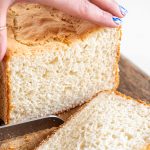
Gluten-free White Breadmaker Loaf Recipe (dairy-free)
Ingredients
- 200 ml milk dairy-free if necessary
- 200 ml water
- 55 ml vegetable oil
- 2 large eggs beaten
- 1 tsp cider vinegar
- 2 tbsp caster sugar
- 450 g gluten-free white bread flour I use Doves Farm's FREEE flour
- 1 tsp salt
- 1 tsp xanthan gum
- 9 g easy-bake yeast ensure gluten-free
Instructions
- Warm your milk and water together in a jug then add them to the bread pan along with your oil, cider vinegar and beaten eggs.
- Add your sugar to the pan.
- Then add the dry ingredients – your gluten free flour, salt and xanthan gum.
- Put the bread pan into the bread maker and add your yeast to the yeast dispenser. If your breadmaker doesn't have a yeast dispenser, add it on top of the rest of the ingredients.
- Turn the breadmaker (I use the Panasonic 2540 breadmaker) on the gluten free bread setting and then put the dark crust option on too (setting 15 on my breadmaker). Allow to bake - mine bakes for 1 hour 55 minutes.
- Once done, remove the pan from the bread maker, remove the bread and allow to fully cool before slicing.
Notes
Thanks for reading all about my gluten-free white breadmaker loaf recipe! If you make it, I’d love to see how it turned out so don’t forget to take a snap of your creations and tag me on Instagram!
Any questions about the recipe? Please do let me know by following me on Instagram and leaving me a comment on a recent photo!
Thanks for reading,
Becky xxx

